An Analysis of Operations Management and Logistics at Toyota (Essay)
VerifiedAdded on 2021/01/01
|11
|3507
|421
Essay
AI Summary
This essay provides a comprehensive analysis of Toyota's operations management and logistics strategies. It begins with an introduction to operations management and logistics, highlighting their significance in business growth and efficiency, followed by an overview of Toyota as a multinational automotive manufacturer. The essay then delves into two key topics: quality management and location & layout, exploring concepts like Total Quality Management (TQM) and Alfred Weber's theory of industrial location, respectively. It examines the application of TQM within Toyota, emphasizing its role in maintaining product and service quality, and discusses Weber's theory in the context of plant location decisions, considering factors like transportation and labor costs. Furthermore, the essay explores lean and agile management practices for waste minimization and Six Sigma for quality control. It concludes with a brief overview of the Triple Bottom Line, emphasizing the importance of sustainability in operations management.
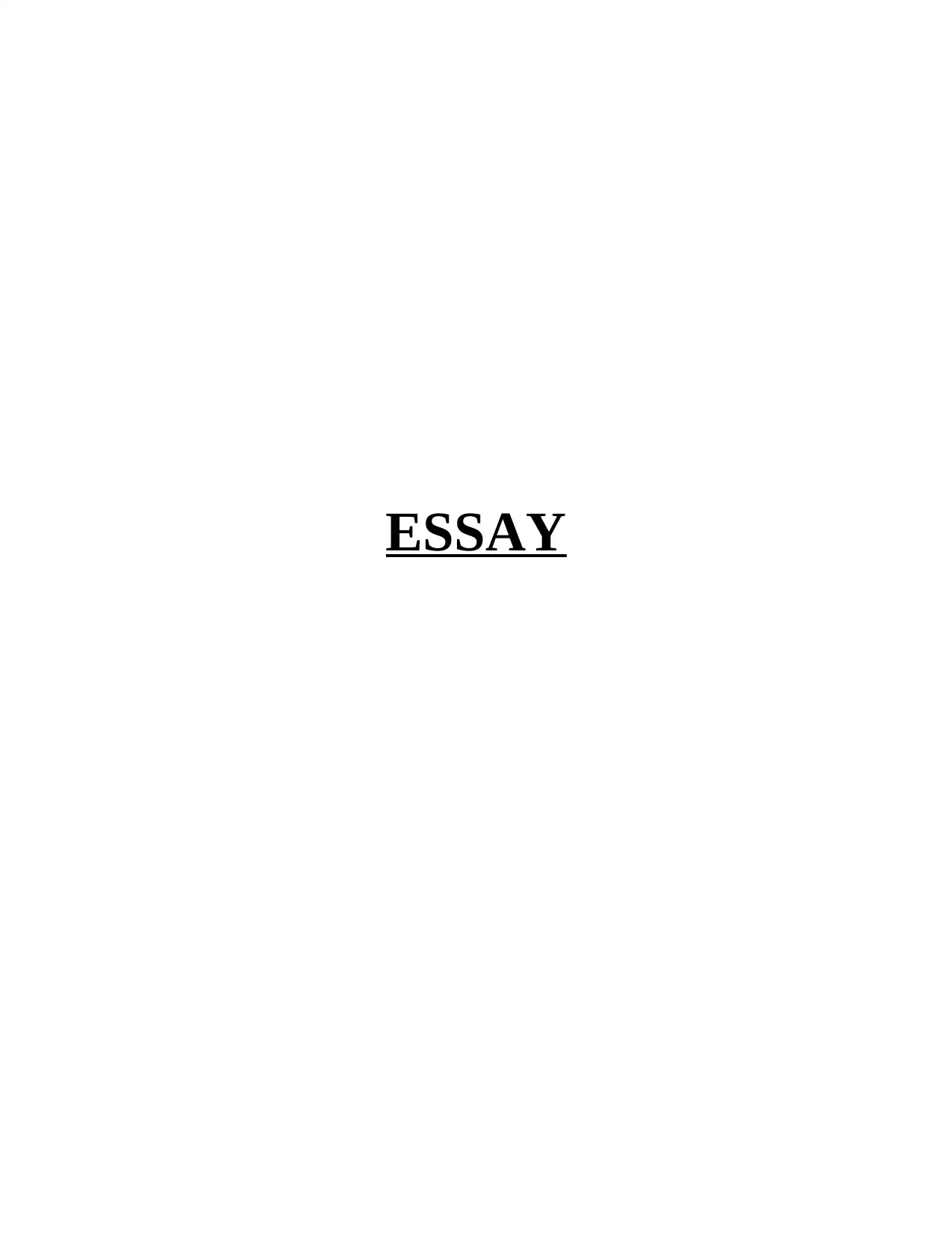
ESSAY
Paraphrase This Document
Need a fresh take? Get an instant paraphrase of this document with our AI Paraphraser
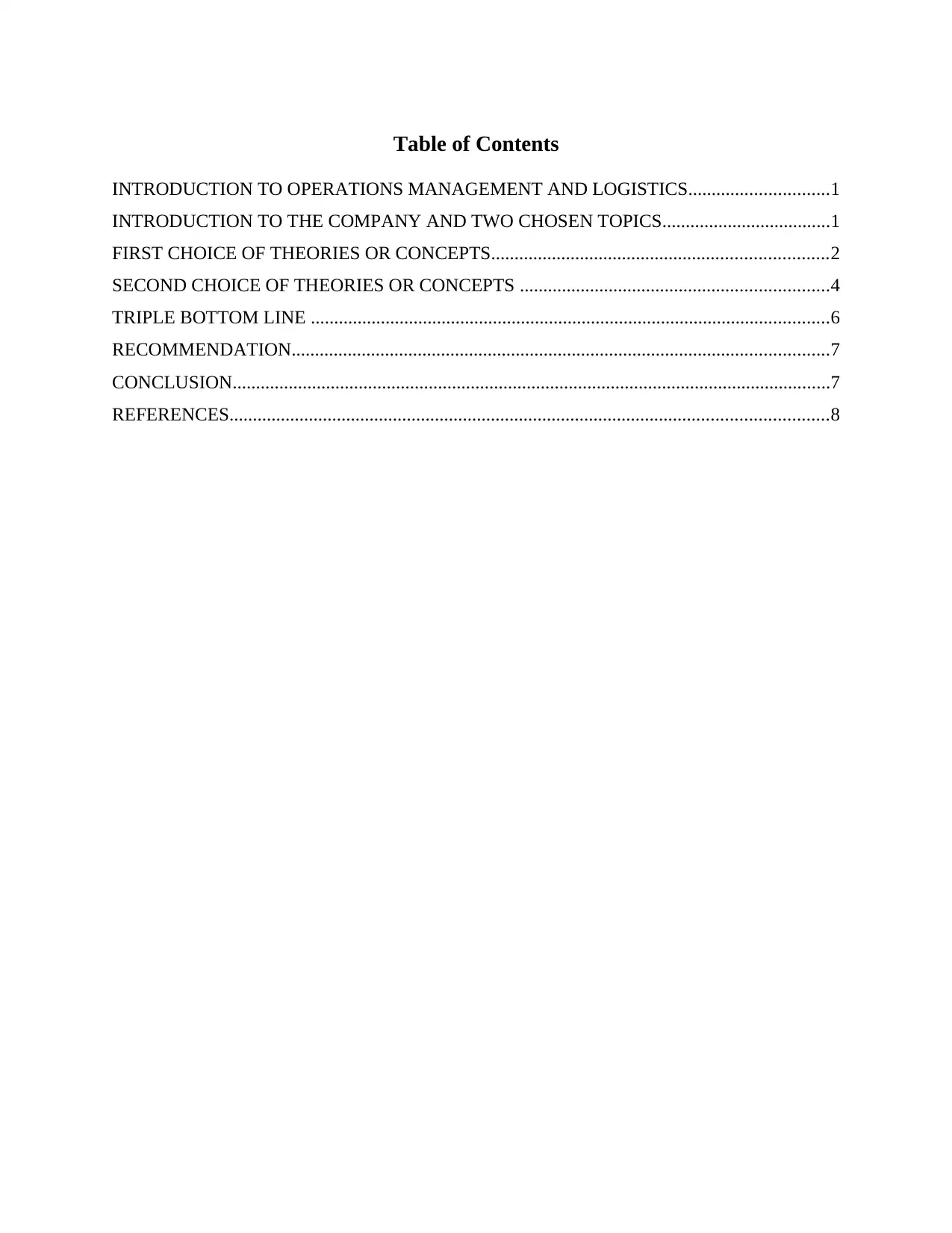
Table of Contents
INTRODUCTION TO OPERATIONS MANAGEMENT AND LOGISTICS..............................1
INTRODUCTION TO THE COMPANY AND TWO CHOSEN TOPICS....................................1
FIRST CHOICE OF THEORIES OR CONCEPTS........................................................................2
SECOND CHOICE OF THEORIES OR CONCEPTS ..................................................................4
TRIPLE BOTTOM LINE ...............................................................................................................6
RECOMMENDATION...................................................................................................................7
CONCLUSION................................................................................................................................7
REFERENCES................................................................................................................................8
INTRODUCTION TO OPERATIONS MANAGEMENT AND LOGISTICS..............................1
INTRODUCTION TO THE COMPANY AND TWO CHOSEN TOPICS....................................1
FIRST CHOICE OF THEORIES OR CONCEPTS........................................................................2
SECOND CHOICE OF THEORIES OR CONCEPTS ..................................................................4
TRIPLE BOTTOM LINE ...............................................................................................................6
RECOMMENDATION...................................................................................................................7
CONCLUSION................................................................................................................................7
REFERENCES................................................................................................................................8
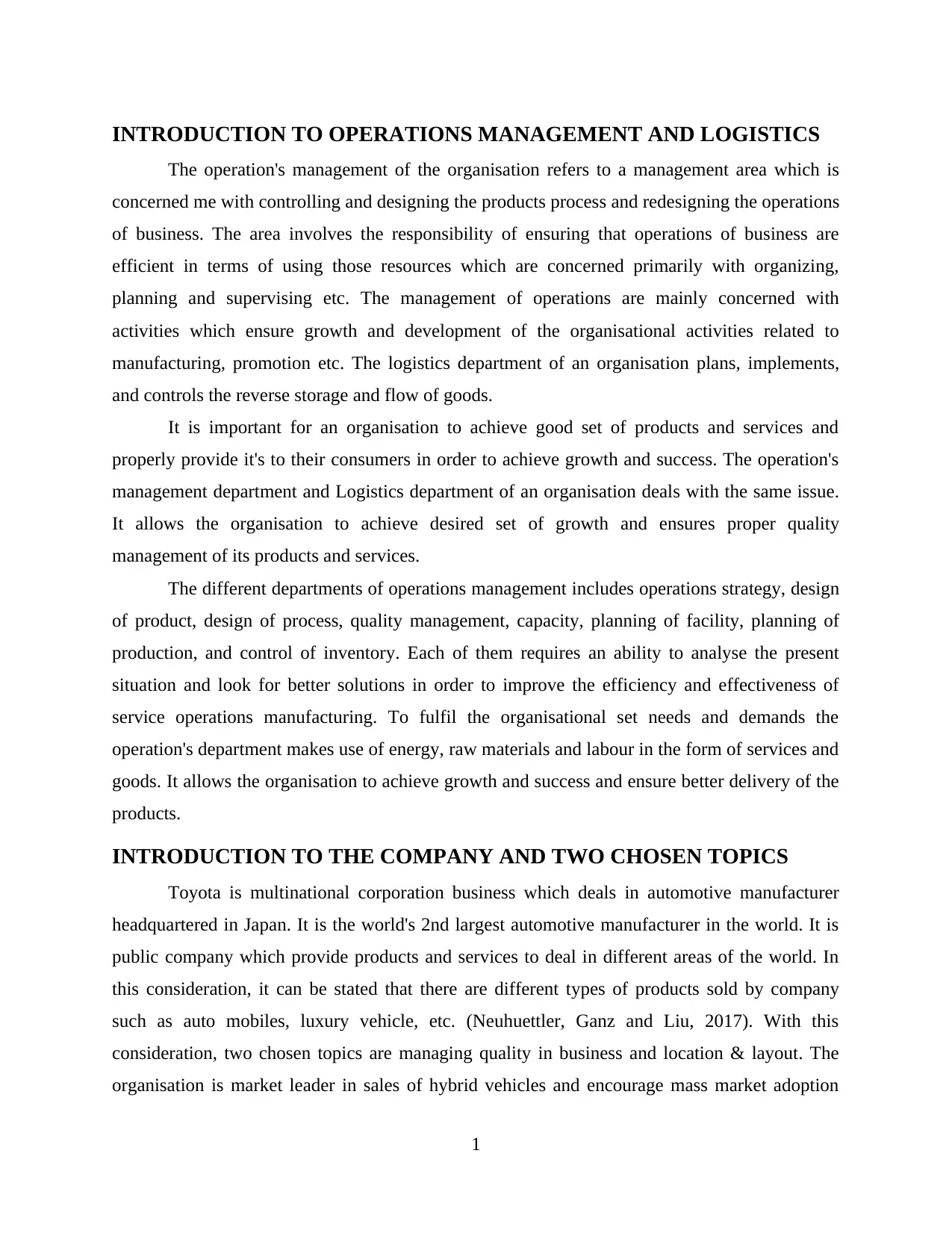
INTRODUCTION TO OPERATIONS MANAGEMENT AND LOGISTICS
The operation's management of the organisation refers to a management area which is
concerned me with controlling and designing the products process and redesigning the operations
of business. The area involves the responsibility of ensuring that operations of business are
efficient in terms of using those resources which are concerned primarily with organizing,
planning and supervising etc. The management of operations are mainly concerned with
activities which ensure growth and development of the organisational activities related to
manufacturing, promotion etc. The logistics department of an organisation plans, implements,
and controls the reverse storage and flow of goods.
It is important for an organisation to achieve good set of products and services and
properly provide it's to their consumers in order to achieve growth and success. The operation's
management department and Logistics department of an organisation deals with the same issue.
It allows the organisation to achieve desired set of growth and ensures proper quality
management of its products and services.
The different departments of operations management includes operations strategy, design
of product, design of process, quality management, capacity, planning of facility, planning of
production, and control of inventory. Each of them requires an ability to analyse the present
situation and look for better solutions in order to improve the efficiency and effectiveness of
service operations manufacturing. To fulfil the organisational set needs and demands the
operation's department makes use of energy, raw materials and labour in the form of services and
goods. It allows the organisation to achieve growth and success and ensure better delivery of the
products.
INTRODUCTION TO THE COMPANY AND TWO CHOSEN TOPICS
Toyota is multinational corporation business which deals in automotive manufacturer
headquartered in Japan. It is the world's 2nd largest automotive manufacturer in the world. It is
public company which provide products and services to deal in different areas of the world. In
this consideration, it can be stated that there are different types of products sold by company
such as auto mobiles, luxury vehicle, etc. (Neuhuettler, Ganz and Liu, 2017). With this
consideration, two chosen topics are managing quality in business and location & layout. The
organisation is market leader in sales of hybrid vehicles and encourage mass market adoption
1
The operation's management of the organisation refers to a management area which is
concerned me with controlling and designing the products process and redesigning the operations
of business. The area involves the responsibility of ensuring that operations of business are
efficient in terms of using those resources which are concerned primarily with organizing,
planning and supervising etc. The management of operations are mainly concerned with
activities which ensure growth and development of the organisational activities related to
manufacturing, promotion etc. The logistics department of an organisation plans, implements,
and controls the reverse storage and flow of goods.
It is important for an organisation to achieve good set of products and services and
properly provide it's to their consumers in order to achieve growth and success. The operation's
management department and Logistics department of an organisation deals with the same issue.
It allows the organisation to achieve desired set of growth and ensures proper quality
management of its products and services.
The different departments of operations management includes operations strategy, design
of product, design of process, quality management, capacity, planning of facility, planning of
production, and control of inventory. Each of them requires an ability to analyse the present
situation and look for better solutions in order to improve the efficiency and effectiveness of
service operations manufacturing. To fulfil the organisational set needs and demands the
operation's department makes use of energy, raw materials and labour in the form of services and
goods. It allows the organisation to achieve growth and success and ensure better delivery of the
products.
INTRODUCTION TO THE COMPANY AND TWO CHOSEN TOPICS
Toyota is multinational corporation business which deals in automotive manufacturer
headquartered in Japan. It is the world's 2nd largest automotive manufacturer in the world. It is
public company which provide products and services to deal in different areas of the world. In
this consideration, it can be stated that there are different types of products sold by company
such as auto mobiles, luxury vehicle, etc. (Neuhuettler, Ganz and Liu, 2017). With this
consideration, two chosen topics are managing quality in business and location & layout. The
organisation is market leader in sales of hybrid vehicles and encourage mass market adoption
1
⊘ This is a preview!⊘
Do you want full access?
Subscribe today to unlock all pages.

Trusted by 1+ million students worldwide
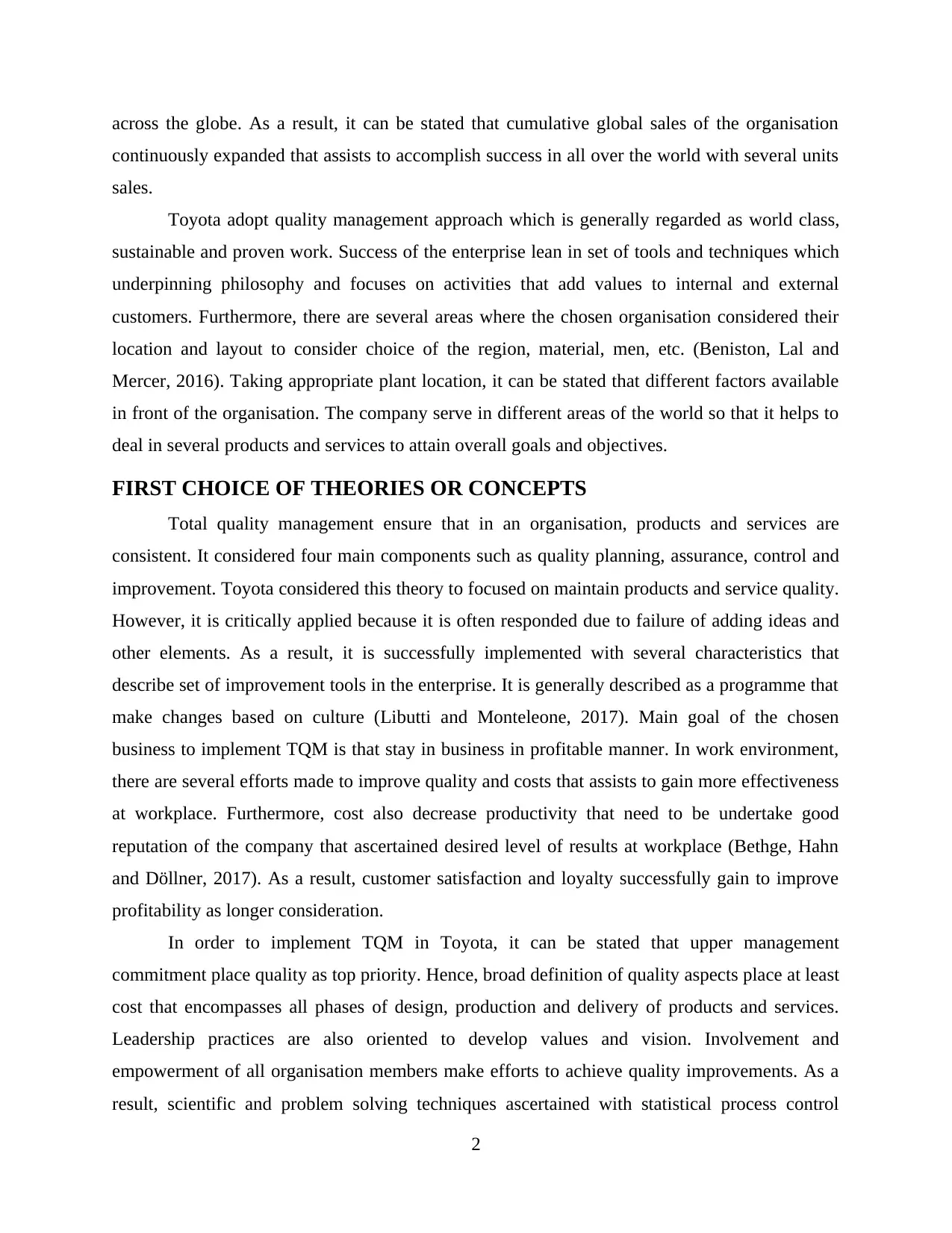
across the globe. As a result, it can be stated that cumulative global sales of the organisation
continuously expanded that assists to accomplish success in all over the world with several units
sales.
Toyota adopt quality management approach which is generally regarded as world class,
sustainable and proven work. Success of the enterprise lean in set of tools and techniques which
underpinning philosophy and focuses on activities that add values to internal and external
customers. Furthermore, there are several areas where the chosen organisation considered their
location and layout to consider choice of the region, material, men, etc. (Beniston, Lal and
Mercer, 2016). Taking appropriate plant location, it can be stated that different factors available
in front of the organisation. The company serve in different areas of the world so that it helps to
deal in several products and services to attain overall goals and objectives.
FIRST CHOICE OF THEORIES OR CONCEPTS
Total quality management ensure that in an organisation, products and services are
consistent. It considered four main components such as quality planning, assurance, control and
improvement. Toyota considered this theory to focused on maintain products and service quality.
However, it is critically applied because it is often responded due to failure of adding ideas and
other elements. As a result, it is successfully implemented with several characteristics that
describe set of improvement tools in the enterprise. It is generally described as a programme that
make changes based on culture (Libutti and Monteleone, 2017). Main goal of the chosen
business to implement TQM is that stay in business in profitable manner. In work environment,
there are several efforts made to improve quality and costs that assists to gain more effectiveness
at workplace. Furthermore, cost also decrease productivity that need to be undertake good
reputation of the company that ascertained desired level of results at workplace (Bethge, Hahn
and Döllner, 2017). As a result, customer satisfaction and loyalty successfully gain to improve
profitability as longer consideration.
In order to implement TQM in Toyota, it can be stated that upper management
commitment place quality as top priority. Hence, broad definition of quality aspects place at least
cost that encompasses all phases of design, production and delivery of products and services.
Leadership practices are also oriented to develop values and vision. Involvement and
empowerment of all organisation members make efforts to achieve quality improvements. As a
result, scientific and problem solving techniques ascertained with statistical process control
2
continuously expanded that assists to accomplish success in all over the world with several units
sales.
Toyota adopt quality management approach which is generally regarded as world class,
sustainable and proven work. Success of the enterprise lean in set of tools and techniques which
underpinning philosophy and focuses on activities that add values to internal and external
customers. Furthermore, there are several areas where the chosen organisation considered their
location and layout to consider choice of the region, material, men, etc. (Beniston, Lal and
Mercer, 2016). Taking appropriate plant location, it can be stated that different factors available
in front of the organisation. The company serve in different areas of the world so that it helps to
deal in several products and services to attain overall goals and objectives.
FIRST CHOICE OF THEORIES OR CONCEPTS
Total quality management ensure that in an organisation, products and services are
consistent. It considered four main components such as quality planning, assurance, control and
improvement. Toyota considered this theory to focused on maintain products and service quality.
However, it is critically applied because it is often responded due to failure of adding ideas and
other elements. As a result, it is successfully implemented with several characteristics that
describe set of improvement tools in the enterprise. It is generally described as a programme that
make changes based on culture (Libutti and Monteleone, 2017). Main goal of the chosen
business to implement TQM is that stay in business in profitable manner. In work environment,
there are several efforts made to improve quality and costs that assists to gain more effectiveness
at workplace. Furthermore, cost also decrease productivity that need to be undertake good
reputation of the company that ascertained desired level of results at workplace (Bethge, Hahn
and Döllner, 2017). As a result, customer satisfaction and loyalty successfully gain to improve
profitability as longer consideration.
In order to implement TQM in Toyota, it can be stated that upper management
commitment place quality as top priority. Hence, broad definition of quality aspects place at least
cost that encompasses all phases of design, production and delivery of products and services.
Leadership practices are also oriented to develop values and vision. Involvement and
empowerment of all organisation members make efforts to achieve quality improvements. As a
result, scientific and problem solving techniques ascertained with statistical process control
2
Paraphrase This Document
Need a fresh take? Get an instant paraphrase of this document with our AI Paraphraser
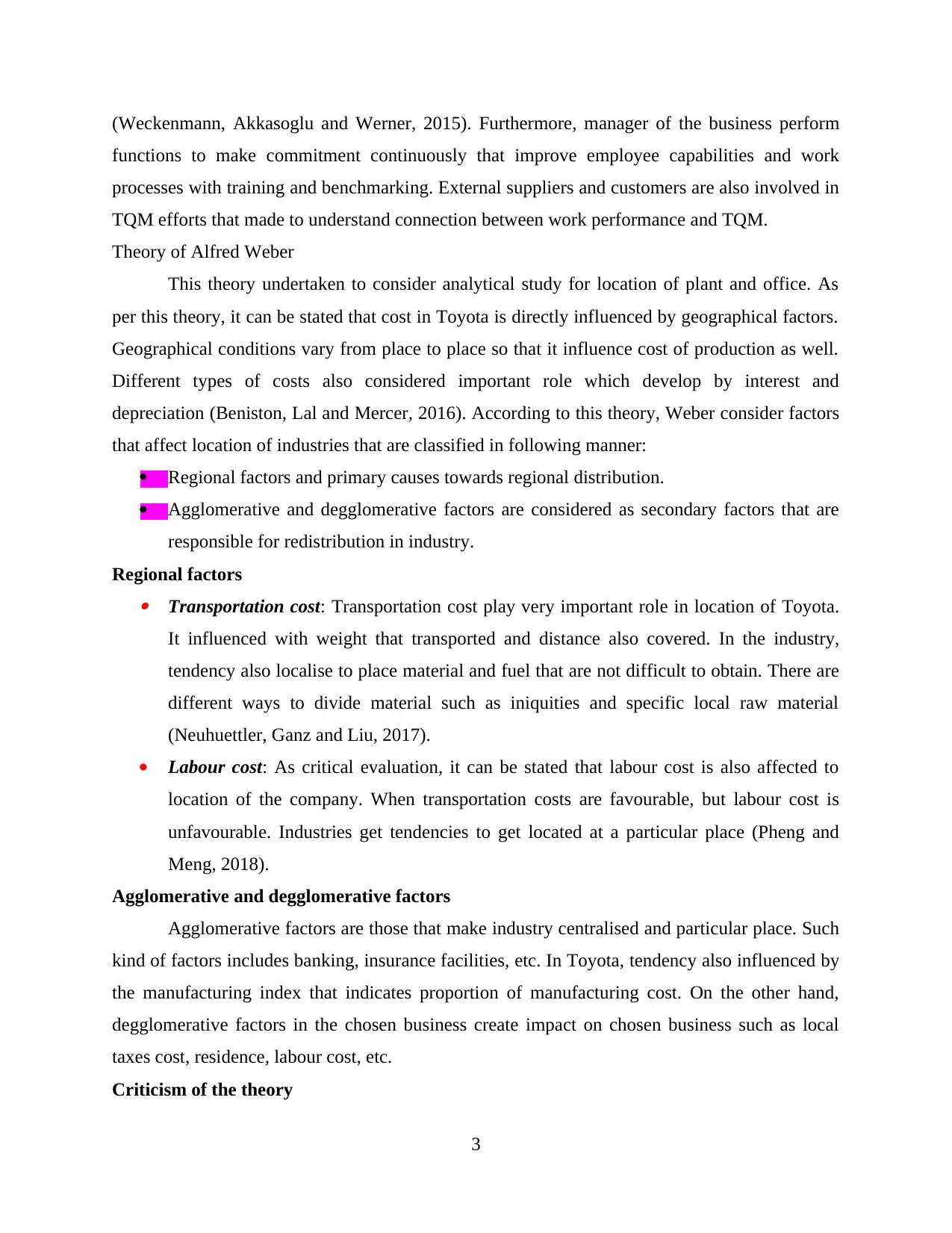
(Weckenmann, Akkasoglu and Werner, 2015). Furthermore, manager of the business perform
functions to make commitment continuously that improve employee capabilities and work
processes with training and benchmarking. External suppliers and customers are also involved in
TQM efforts that made to understand connection between work performance and TQM.
Theory of Alfred Weber
This theory undertaken to consider analytical study for location of plant and office. As
per this theory, it can be stated that cost in Toyota is directly influenced by geographical factors.
Geographical conditions vary from place to place so that it influence cost of production as well.
Different types of costs also considered important role which develop by interest and
depreciation (Beniston, Lal and Mercer, 2016). According to this theory, Weber consider factors
that affect location of industries that are classified in following manner:
Regional factors and primary causes towards regional distribution.
Agglomerative and degglomerative factors are considered as secondary factors that are
responsible for redistribution in industry.
Regional factors Transportation cost: Transportation cost play very important role in location of Toyota.
It influenced with weight that transported and distance also covered. In the industry,
tendency also localise to place material and fuel that are not difficult to obtain. There are
different ways to divide material such as iniquities and specific local raw material
(Neuhuettler, Ganz and Liu, 2017).
Labour cost: As critical evaluation, it can be stated that labour cost is also affected to
location of the company. When transportation costs are favourable, but labour cost is
unfavourable. Industries get tendencies to get located at a particular place (Pheng and
Meng, 2018).
Agglomerative and degglomerative factors
Agglomerative factors are those that make industry centralised and particular place. Such
kind of factors includes banking, insurance facilities, etc. In Toyota, tendency also influenced by
the manufacturing index that indicates proportion of manufacturing cost. On the other hand,
degglomerative factors in the chosen business create impact on chosen business such as local
taxes cost, residence, labour cost, etc.
Criticism of the theory
3
functions to make commitment continuously that improve employee capabilities and work
processes with training and benchmarking. External suppliers and customers are also involved in
TQM efforts that made to understand connection between work performance and TQM.
Theory of Alfred Weber
This theory undertaken to consider analytical study for location of plant and office. As
per this theory, it can be stated that cost in Toyota is directly influenced by geographical factors.
Geographical conditions vary from place to place so that it influence cost of production as well.
Different types of costs also considered important role which develop by interest and
depreciation (Beniston, Lal and Mercer, 2016). According to this theory, Weber consider factors
that affect location of industries that are classified in following manner:
Regional factors and primary causes towards regional distribution.
Agglomerative and degglomerative factors are considered as secondary factors that are
responsible for redistribution in industry.
Regional factors Transportation cost: Transportation cost play very important role in location of Toyota.
It influenced with weight that transported and distance also covered. In the industry,
tendency also localise to place material and fuel that are not difficult to obtain. There are
different ways to divide material such as iniquities and specific local raw material
(Neuhuettler, Ganz and Liu, 2017).
Labour cost: As critical evaluation, it can be stated that labour cost is also affected to
location of the company. When transportation costs are favourable, but labour cost is
unfavourable. Industries get tendencies to get located at a particular place (Pheng and
Meng, 2018).
Agglomerative and degglomerative factors
Agglomerative factors are those that make industry centralised and particular place. Such
kind of factors includes banking, insurance facilities, etc. In Toyota, tendency also influenced by
the manufacturing index that indicates proportion of manufacturing cost. On the other hand,
degglomerative factors in the chosen business create impact on chosen business such as local
taxes cost, residence, labour cost, etc.
Criticism of the theory
3
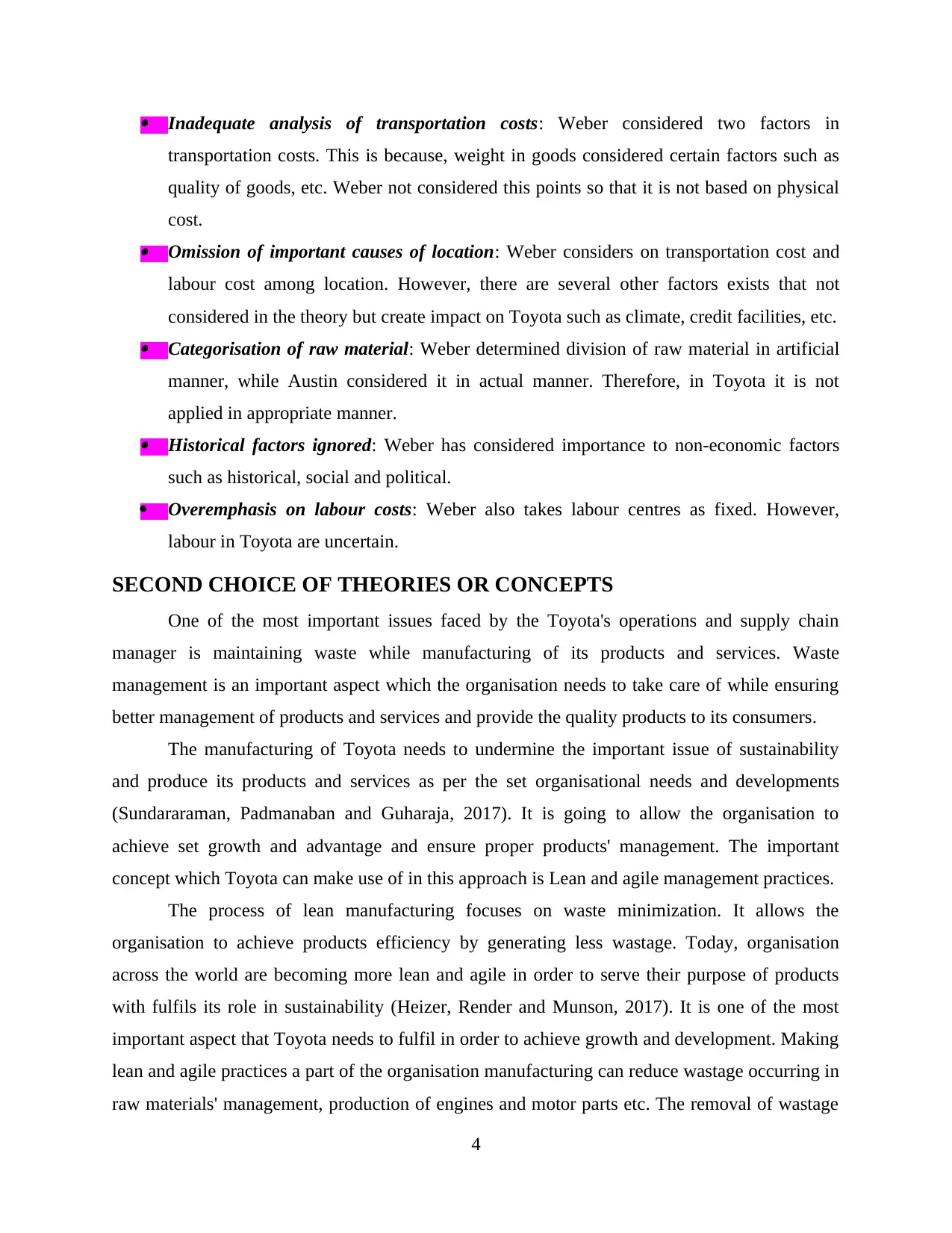
Inadequate analysis of transportation costs: Weber considered two factors in
transportation costs. This is because, weight in goods considered certain factors such as
quality of goods, etc. Weber not considered this points so that it is not based on physical
cost. Omission of important causes of location: Weber considers on transportation cost and
labour cost among location. However, there are several other factors exists that not
considered in the theory but create impact on Toyota such as climate, credit facilities, etc. Categorisation of raw material: Weber determined division of raw material in artificial
manner, while Austin considered it in actual manner. Therefore, in Toyota it is not
applied in appropriate manner. Historical factors ignored: Weber has considered importance to non-economic factors
such as historical, social and political.
Overemphasis on labour costs: Weber also takes labour centres as fixed. However,
labour in Toyota are uncertain.
SECOND CHOICE OF THEORIES OR CONCEPTS
One of the most important issues faced by the Toyota's operations and supply chain
manager is maintaining waste while manufacturing of its products and services. Waste
management is an important aspect which the organisation needs to take care of while ensuring
better management of products and services and provide the quality products to its consumers.
The manufacturing of Toyota needs to undermine the important issue of sustainability
and produce its products and services as per the set organisational needs and developments
(Sundararaman, Padmanaban and Guharaja, 2017). It is going to allow the organisation to
achieve set growth and advantage and ensure proper products' management. The important
concept which Toyota can make use of in this approach is Lean and agile management practices.
The process of lean manufacturing focuses on waste minimization. It allows the
organisation to achieve products efficiency by generating less wastage. Today, organisation
across the world are becoming more lean and agile in order to serve their purpose of products
with fulfils its role in sustainability (Heizer, Render and Munson, 2017). It is one of the most
important aspect that Toyota needs to fulfil in order to achieve growth and development. Making
lean and agile practices a part of the organisation manufacturing can reduce wastage occurring in
raw materials' management, production of engines and motor parts etc. The removal of wastage
4
transportation costs. This is because, weight in goods considered certain factors such as
quality of goods, etc. Weber not considered this points so that it is not based on physical
cost. Omission of important causes of location: Weber considers on transportation cost and
labour cost among location. However, there are several other factors exists that not
considered in the theory but create impact on Toyota such as climate, credit facilities, etc. Categorisation of raw material: Weber determined division of raw material in artificial
manner, while Austin considered it in actual manner. Therefore, in Toyota it is not
applied in appropriate manner. Historical factors ignored: Weber has considered importance to non-economic factors
such as historical, social and political.
Overemphasis on labour costs: Weber also takes labour centres as fixed. However,
labour in Toyota are uncertain.
SECOND CHOICE OF THEORIES OR CONCEPTS
One of the most important issues faced by the Toyota's operations and supply chain
manager is maintaining waste while manufacturing of its products and services. Waste
management is an important aspect which the organisation needs to take care of while ensuring
better management of products and services and provide the quality products to its consumers.
The manufacturing of Toyota needs to undermine the important issue of sustainability
and produce its products and services as per the set organisational needs and developments
(Sundararaman, Padmanaban and Guharaja, 2017). It is going to allow the organisation to
achieve set growth and advantage and ensure proper products' management. The important
concept which Toyota can make use of in this approach is Lean and agile management practices.
The process of lean manufacturing focuses on waste minimization. It allows the
organisation to achieve products efficiency by generating less wastage. Today, organisation
across the world are becoming more lean and agile in order to serve their purpose of products
with fulfils its role in sustainability (Heizer, Render and Munson, 2017). It is one of the most
important aspect that Toyota needs to fulfil in order to achieve growth and development. Making
lean and agile practices a part of the organisation manufacturing can reduce wastage occurring in
raw materials' management, production of engines and motor parts etc. The removal of wastage
4
⊘ This is a preview!⊘
Do you want full access?
Subscribe today to unlock all pages.

Trusted by 1+ million students worldwide
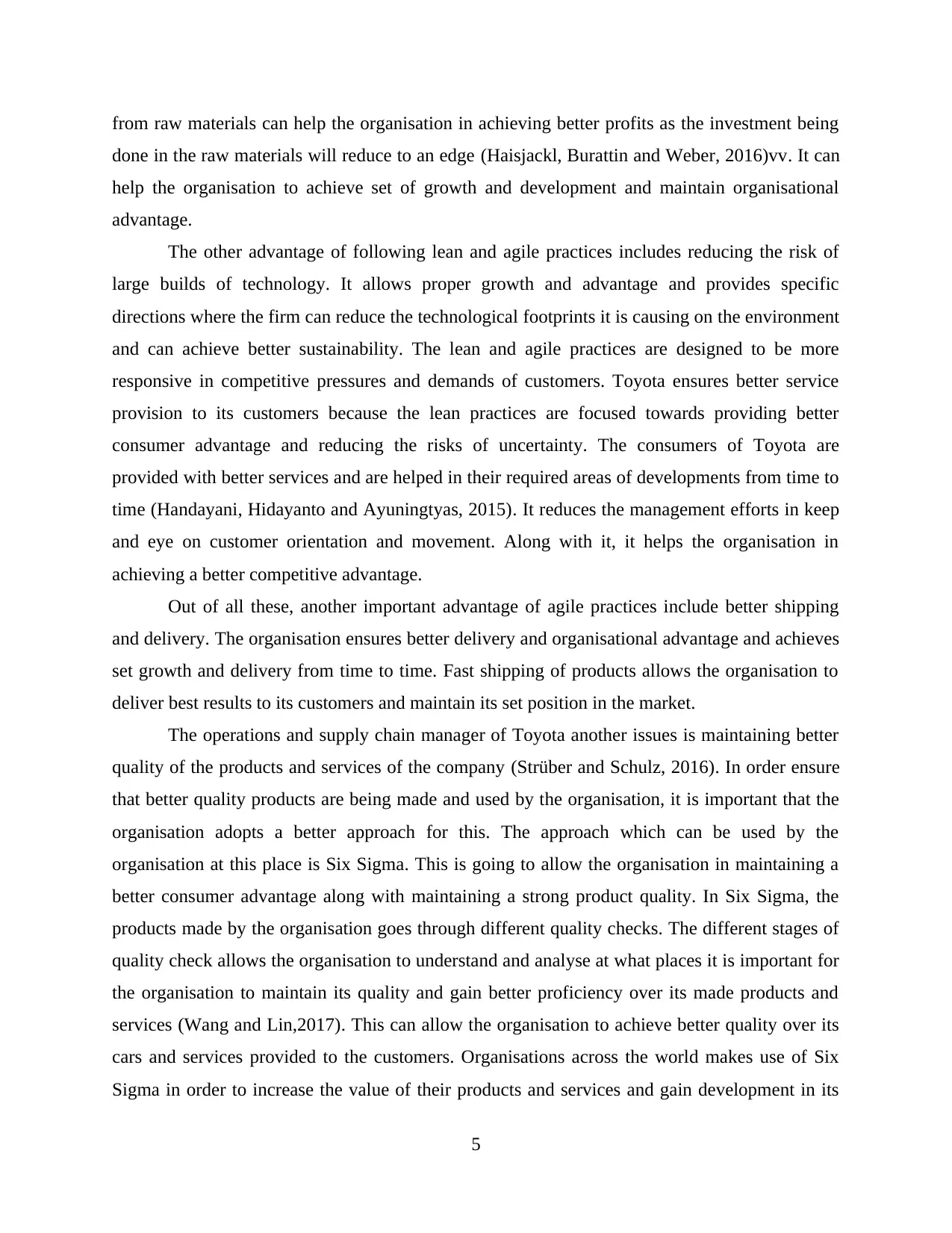
from raw materials can help the organisation in achieving better profits as the investment being
done in the raw materials will reduce to an edge (Haisjackl, Burattin and Weber, 2016)vv. It can
help the organisation to achieve set of growth and development and maintain organisational
advantage.
The other advantage of following lean and agile practices includes reducing the risk of
large builds of technology. It allows proper growth and advantage and provides specific
directions where the firm can reduce the technological footprints it is causing on the environment
and can achieve better sustainability. The lean and agile practices are designed to be more
responsive in competitive pressures and demands of customers. Toyota ensures better service
provision to its customers because the lean practices are focused towards providing better
consumer advantage and reducing the risks of uncertainty. The consumers of Toyota are
provided with better services and are helped in their required areas of developments from time to
time (Handayani, Hidayanto and Ayuningtyas, 2015). It reduces the management efforts in keep
and eye on customer orientation and movement. Along with it, it helps the organisation in
achieving a better competitive advantage.
Out of all these, another important advantage of agile practices include better shipping
and delivery. The organisation ensures better delivery and organisational advantage and achieves
set growth and delivery from time to time. Fast shipping of products allows the organisation to
deliver best results to its customers and maintain its set position in the market.
The operations and supply chain manager of Toyota another issues is maintaining better
quality of the products and services of the company (Strüber and Schulz, 2016). In order ensure
that better quality products are being made and used by the organisation, it is important that the
organisation adopts a better approach for this. The approach which can be used by the
organisation at this place is Six Sigma. This is going to allow the organisation in maintaining a
better consumer advantage along with maintaining a strong product quality. In Six Sigma, the
products made by the organisation goes through different quality checks. The different stages of
quality check allows the organisation to understand and analyse at what places it is important for
the organisation to maintain its quality and gain better proficiency over its made products and
services (Wang and Lin,2017). This can allow the organisation to achieve better quality over its
cars and services provided to the customers. Organisations across the world makes use of Six
Sigma in order to increase the value of their products and services and gain development in its
5
done in the raw materials will reduce to an edge (Haisjackl, Burattin and Weber, 2016)vv. It can
help the organisation to achieve set of growth and development and maintain organisational
advantage.
The other advantage of following lean and agile practices includes reducing the risk of
large builds of technology. It allows proper growth and advantage and provides specific
directions where the firm can reduce the technological footprints it is causing on the environment
and can achieve better sustainability. The lean and agile practices are designed to be more
responsive in competitive pressures and demands of customers. Toyota ensures better service
provision to its customers because the lean practices are focused towards providing better
consumer advantage and reducing the risks of uncertainty. The consumers of Toyota are
provided with better services and are helped in their required areas of developments from time to
time (Handayani, Hidayanto and Ayuningtyas, 2015). It reduces the management efforts in keep
and eye on customer orientation and movement. Along with it, it helps the organisation in
achieving a better competitive advantage.
Out of all these, another important advantage of agile practices include better shipping
and delivery. The organisation ensures better delivery and organisational advantage and achieves
set growth and delivery from time to time. Fast shipping of products allows the organisation to
deliver best results to its customers and maintain its set position in the market.
The operations and supply chain manager of Toyota another issues is maintaining better
quality of the products and services of the company (Strüber and Schulz, 2016). In order ensure
that better quality products are being made and used by the organisation, it is important that the
organisation adopts a better approach for this. The approach which can be used by the
organisation at this place is Six Sigma. This is going to allow the organisation in maintaining a
better consumer advantage along with maintaining a strong product quality. In Six Sigma, the
products made by the organisation goes through different quality checks. The different stages of
quality check allows the organisation to understand and analyse at what places it is important for
the organisation to maintain its quality and gain better proficiency over its made products and
services (Wang and Lin,2017). This can allow the organisation to achieve better quality over its
cars and services provided to the customers. Organisations across the world makes use of Six
Sigma in order to increase the value of their products and services and gain development in its
5
Paraphrase This Document
Need a fresh take? Get an instant paraphrase of this document with our AI Paraphraser
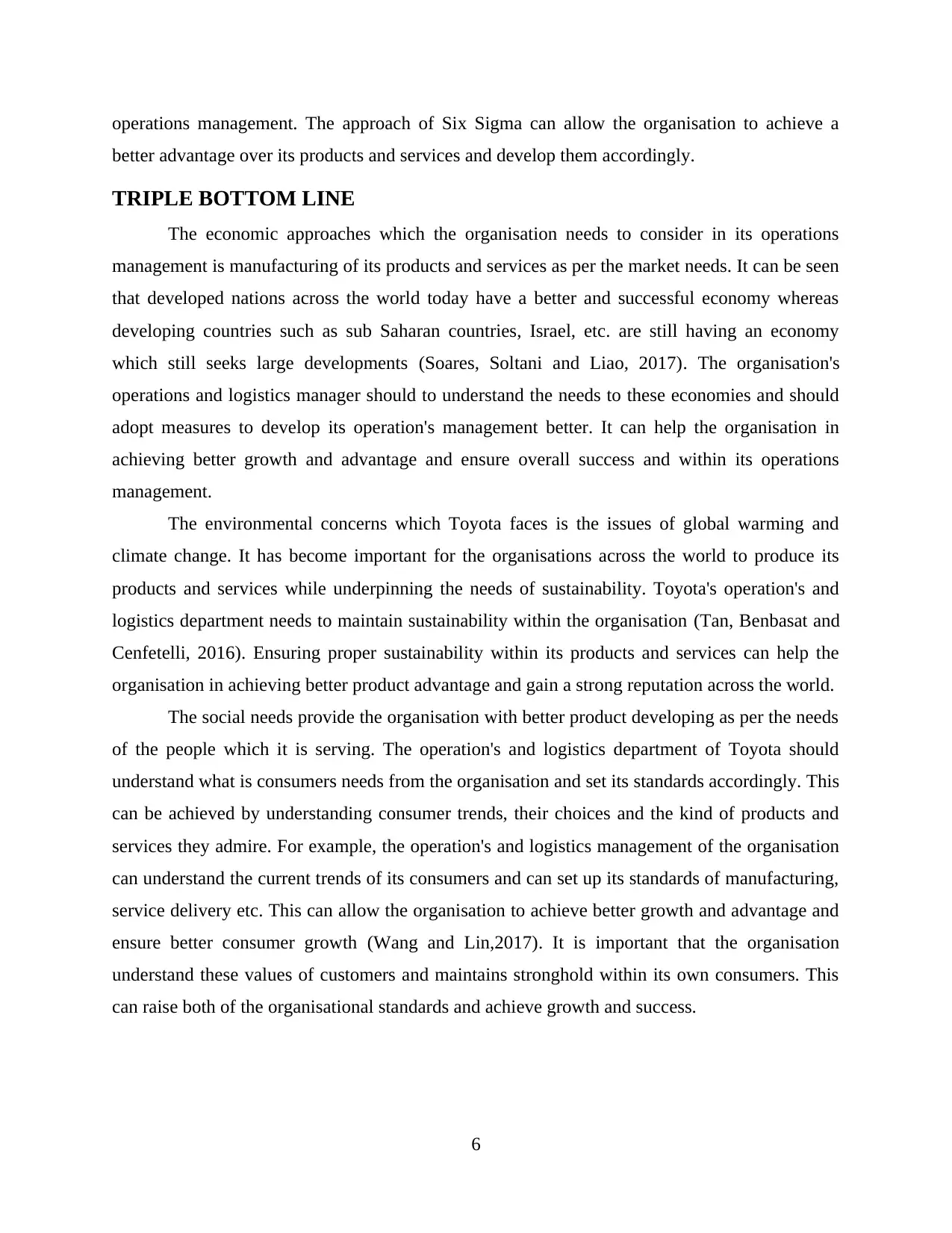
operations management. The approach of Six Sigma can allow the organisation to achieve a
better advantage over its products and services and develop them accordingly.
TRIPLE BOTTOM LINE
The economic approaches which the organisation needs to consider in its operations
management is manufacturing of its products and services as per the market needs. It can be seen
that developed nations across the world today have a better and successful economy whereas
developing countries such as sub Saharan countries, Israel, etc. are still having an economy
which still seeks large developments (Soares, Soltani and Liao, 2017). The organisation's
operations and logistics manager should to understand the needs to these economies and should
adopt measures to develop its operation's management better. It can help the organisation in
achieving better growth and advantage and ensure overall success and within its operations
management.
The environmental concerns which Toyota faces is the issues of global warming and
climate change. It has become important for the organisations across the world to produce its
products and services while underpinning the needs of sustainability. Toyota's operation's and
logistics department needs to maintain sustainability within the organisation (Tan, Benbasat and
Cenfetelli, 2016). Ensuring proper sustainability within its products and services can help the
organisation in achieving better product advantage and gain a strong reputation across the world.
The social needs provide the organisation with better product developing as per the needs
of the people which it is serving. The operation's and logistics department of Toyota should
understand what is consumers needs from the organisation and set its standards accordingly. This
can be achieved by understanding consumer trends, their choices and the kind of products and
services they admire. For example, the operation's and logistics management of the organisation
can understand the current trends of its consumers and can set up its standards of manufacturing,
service delivery etc. This can allow the organisation to achieve better growth and advantage and
ensure better consumer growth (Wang and Lin,2017). It is important that the organisation
understand these values of customers and maintains stronghold within its own consumers. This
can raise both of the organisational standards and achieve growth and success.
6
better advantage over its products and services and develop them accordingly.
TRIPLE BOTTOM LINE
The economic approaches which the organisation needs to consider in its operations
management is manufacturing of its products and services as per the market needs. It can be seen
that developed nations across the world today have a better and successful economy whereas
developing countries such as sub Saharan countries, Israel, etc. are still having an economy
which still seeks large developments (Soares, Soltani and Liao, 2017). The organisation's
operations and logistics manager should to understand the needs to these economies and should
adopt measures to develop its operation's management better. It can help the organisation in
achieving better growth and advantage and ensure overall success and within its operations
management.
The environmental concerns which Toyota faces is the issues of global warming and
climate change. It has become important for the organisations across the world to produce its
products and services while underpinning the needs of sustainability. Toyota's operation's and
logistics department needs to maintain sustainability within the organisation (Tan, Benbasat and
Cenfetelli, 2016). Ensuring proper sustainability within its products and services can help the
organisation in achieving better product advantage and gain a strong reputation across the world.
The social needs provide the organisation with better product developing as per the needs
of the people which it is serving. The operation's and logistics department of Toyota should
understand what is consumers needs from the organisation and set its standards accordingly. This
can be achieved by understanding consumer trends, their choices and the kind of products and
services they admire. For example, the operation's and logistics management of the organisation
can understand the current trends of its consumers and can set up its standards of manufacturing,
service delivery etc. This can allow the organisation to achieve better growth and advantage and
ensure better consumer growth (Wang and Lin,2017). It is important that the organisation
understand these values of customers and maintains stronghold within its own consumers. This
can raise both of the organisational standards and achieve growth and success.
6
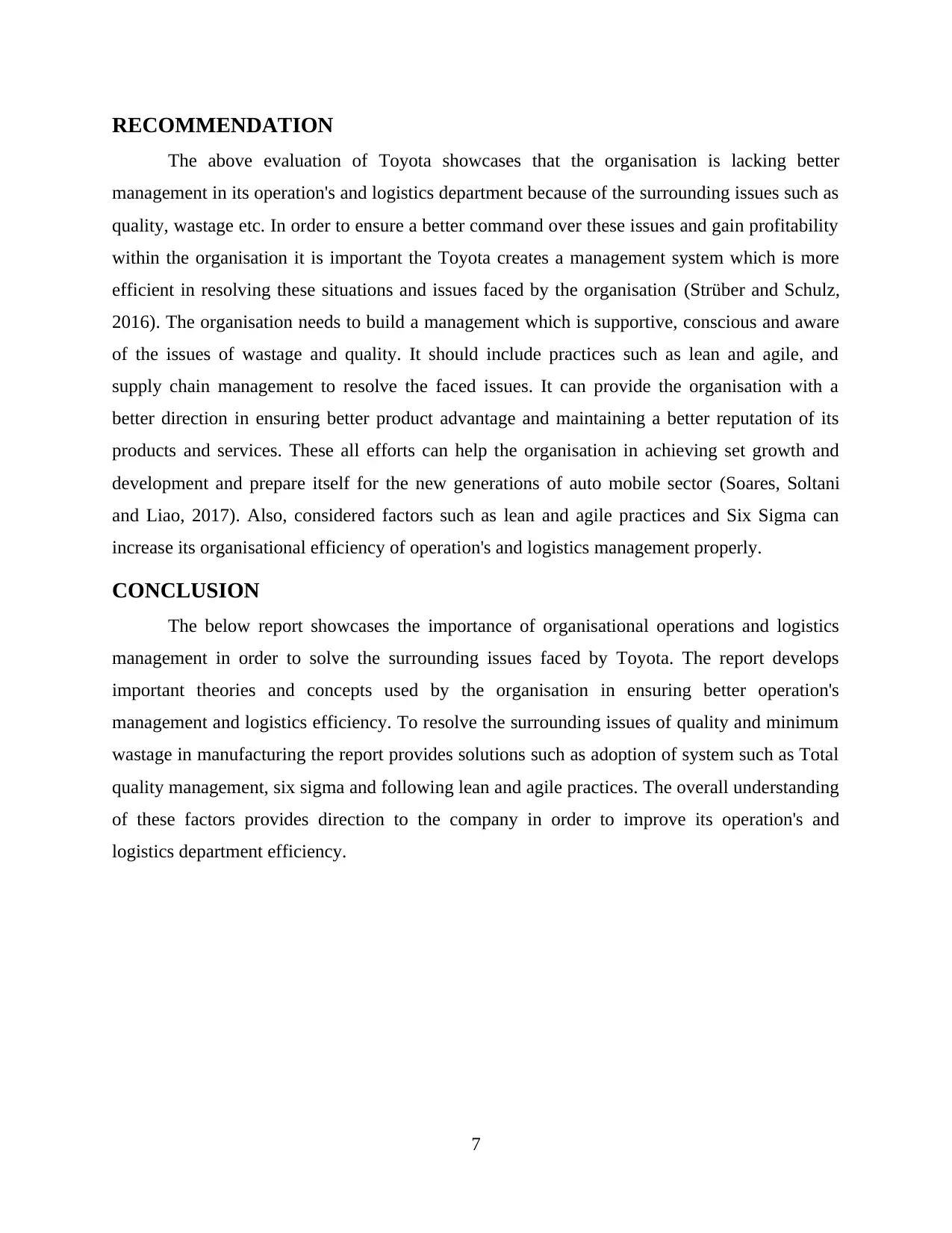
RECOMMENDATION
The above evaluation of Toyota showcases that the organisation is lacking better
management in its operation's and logistics department because of the surrounding issues such as
quality, wastage etc. In order to ensure a better command over these issues and gain profitability
within the organisation it is important the Toyota creates a management system which is more
efficient in resolving these situations and issues faced by the organisation (Strüber and Schulz,
2016). The organisation needs to build a management which is supportive, conscious and aware
of the issues of wastage and quality. It should include practices such as lean and agile, and
supply chain management to resolve the faced issues. It can provide the organisation with a
better direction in ensuring better product advantage and maintaining a better reputation of its
products and services. These all efforts can help the organisation in achieving set growth and
development and prepare itself for the new generations of auto mobile sector (Soares, Soltani
and Liao, 2017). Also, considered factors such as lean and agile practices and Six Sigma can
increase its organisational efficiency of operation's and logistics management properly.
CONCLUSION
The below report showcases the importance of organisational operations and logistics
management in order to solve the surrounding issues faced by Toyota. The report develops
important theories and concepts used by the organisation in ensuring better operation's
management and logistics efficiency. To resolve the surrounding issues of quality and minimum
wastage in manufacturing the report provides solutions such as adoption of system such as Total
quality management, six sigma and following lean and agile practices. The overall understanding
of these factors provides direction to the company in order to improve its operation's and
logistics department efficiency.
7
The above evaluation of Toyota showcases that the organisation is lacking better
management in its operation's and logistics department because of the surrounding issues such as
quality, wastage etc. In order to ensure a better command over these issues and gain profitability
within the organisation it is important the Toyota creates a management system which is more
efficient in resolving these situations and issues faced by the organisation (Strüber and Schulz,
2016). The organisation needs to build a management which is supportive, conscious and aware
of the issues of wastage and quality. It should include practices such as lean and agile, and
supply chain management to resolve the faced issues. It can provide the organisation with a
better direction in ensuring better product advantage and maintaining a better reputation of its
products and services. These all efforts can help the organisation in achieving set growth and
development and prepare itself for the new generations of auto mobile sector (Soares, Soltani
and Liao, 2017). Also, considered factors such as lean and agile practices and Six Sigma can
increase its organisational efficiency of operation's and logistics management properly.
CONCLUSION
The below report showcases the importance of organisational operations and logistics
management in order to solve the surrounding issues faced by Toyota. The report develops
important theories and concepts used by the organisation in ensuring better operation's
management and logistics efficiency. To resolve the surrounding issues of quality and minimum
wastage in manufacturing the report provides solutions such as adoption of system such as Total
quality management, six sigma and following lean and agile practices. The overall understanding
of these factors provides direction to the company in order to improve its operation's and
logistics department efficiency.
7
⊘ This is a preview!⊘
Do you want full access?
Subscribe today to unlock all pages.

Trusted by 1+ million students worldwide
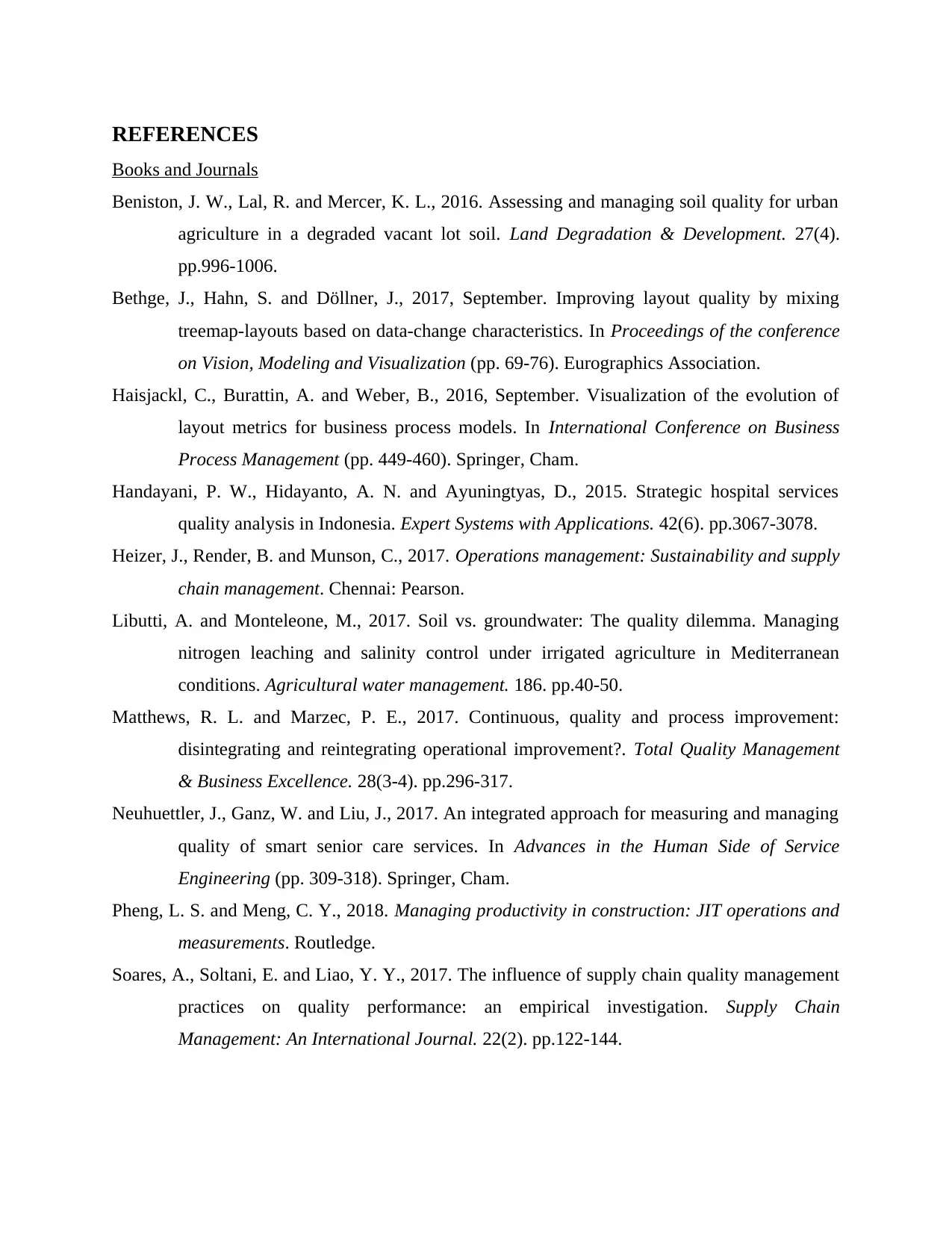
REFERENCES
Books and Journals
Beniston, J. W., Lal, R. and Mercer, K. L., 2016. Assessing and managing soil quality for urban
agriculture in a degraded vacant lot soil. Land Degradation & Development. 27(4).
pp.996-1006.
Bethge, J., Hahn, S. and Döllner, J., 2017, September. Improving layout quality by mixing
treemap-layouts based on data-change characteristics. In Proceedings of the conference
on Vision, Modeling and Visualization (pp. 69-76). Eurographics Association.
Haisjackl, C., Burattin, A. and Weber, B., 2016, September. Visualization of the evolution of
layout metrics for business process models. In International Conference on Business
Process Management (pp. 449-460). Springer, Cham.
Handayani, P. W., Hidayanto, A. N. and Ayuningtyas, D., 2015. Strategic hospital services
quality analysis in Indonesia. Expert Systems with Applications. 42(6). pp.3067-3078.
Heizer, J., Render, B. and Munson, C., 2017. Operations management: Sustainability and supply
chain management. Chennai: Pearson.
Libutti, A. and Monteleone, M., 2017. Soil vs. groundwater: The quality dilemma. Managing
nitrogen leaching and salinity control under irrigated agriculture in Mediterranean
conditions. Agricultural water management. 186. pp.40-50.
Matthews, R. L. and Marzec, P. E., 2017. Continuous, quality and process improvement:
disintegrating and reintegrating operational improvement?. Total Quality Management
& Business Excellence. 28(3-4). pp.296-317.
Neuhuettler, J., Ganz, W. and Liu, J., 2017. An integrated approach for measuring and managing
quality of smart senior care services. In Advances in the Human Side of Service
Engineering (pp. 309-318). Springer, Cham.
Pheng, L. S. and Meng, C. Y., 2018. Managing productivity in construction: JIT operations and
measurements. Routledge.
Soares, A., Soltani, E. and Liao, Y. Y., 2017. The influence of supply chain quality management
practices on quality performance: an empirical investigation. Supply Chain
Management: An International Journal. 22(2). pp.122-144.
Books and Journals
Beniston, J. W., Lal, R. and Mercer, K. L., 2016. Assessing and managing soil quality for urban
agriculture in a degraded vacant lot soil. Land Degradation & Development. 27(4).
pp.996-1006.
Bethge, J., Hahn, S. and Döllner, J., 2017, September. Improving layout quality by mixing
treemap-layouts based on data-change characteristics. In Proceedings of the conference
on Vision, Modeling and Visualization (pp. 69-76). Eurographics Association.
Haisjackl, C., Burattin, A. and Weber, B., 2016, September. Visualization of the evolution of
layout metrics for business process models. In International Conference on Business
Process Management (pp. 449-460). Springer, Cham.
Handayani, P. W., Hidayanto, A. N. and Ayuningtyas, D., 2015. Strategic hospital services
quality analysis in Indonesia. Expert Systems with Applications. 42(6). pp.3067-3078.
Heizer, J., Render, B. and Munson, C., 2017. Operations management: Sustainability and supply
chain management. Chennai: Pearson.
Libutti, A. and Monteleone, M., 2017. Soil vs. groundwater: The quality dilemma. Managing
nitrogen leaching and salinity control under irrigated agriculture in Mediterranean
conditions. Agricultural water management. 186. pp.40-50.
Matthews, R. L. and Marzec, P. E., 2017. Continuous, quality and process improvement:
disintegrating and reintegrating operational improvement?. Total Quality Management
& Business Excellence. 28(3-4). pp.296-317.
Neuhuettler, J., Ganz, W. and Liu, J., 2017. An integrated approach for measuring and managing
quality of smart senior care services. In Advances in the Human Side of Service
Engineering (pp. 309-318). Springer, Cham.
Pheng, L. S. and Meng, C. Y., 2018. Managing productivity in construction: JIT operations and
measurements. Routledge.
Soares, A., Soltani, E. and Liao, Y. Y., 2017. The influence of supply chain quality management
practices on quality performance: an empirical investigation. Supply Chain
Management: An International Journal. 22(2). pp.122-144.
Paraphrase This Document
Need a fresh take? Get an instant paraphrase of this document with our AI Paraphraser
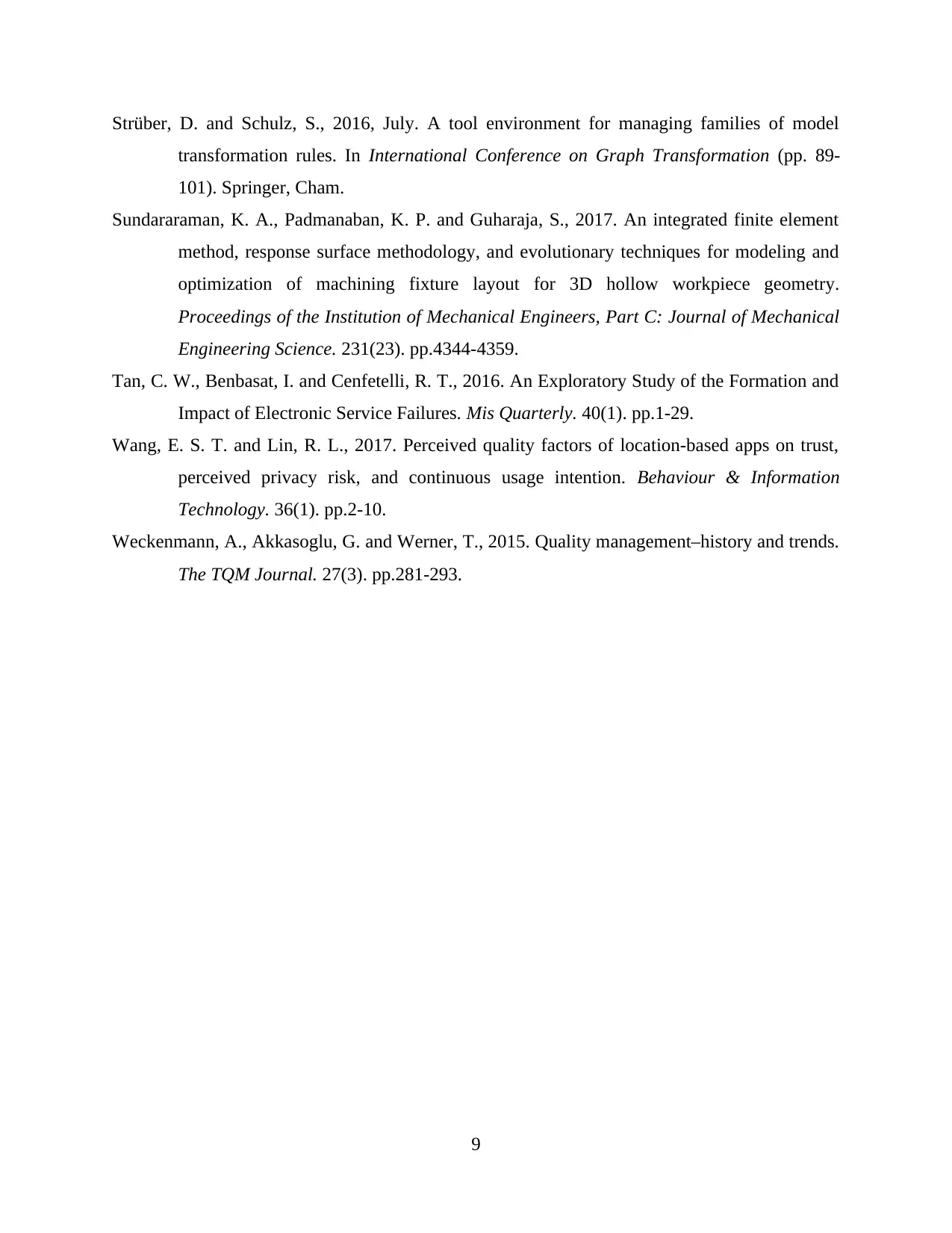
Strüber, D. and Schulz, S., 2016, July. A tool environment for managing families of model
transformation rules. In International Conference on Graph Transformation (pp. 89-
101). Springer, Cham.
Sundararaman, K. A., Padmanaban, K. P. and Guharaja, S., 2017. An integrated finite element
method, response surface methodology, and evolutionary techniques for modeling and
optimization of machining fixture layout for 3D hollow workpiece geometry.
Proceedings of the Institution of Mechanical Engineers, Part C: Journal of Mechanical
Engineering Science. 231(23). pp.4344-4359.
Tan, C. W., Benbasat, I. and Cenfetelli, R. T., 2016. An Exploratory Study of the Formation and
Impact of Electronic Service Failures. Mis Quarterly. 40(1). pp.1-29.
Wang, E. S. T. and Lin, R. L., 2017. Perceived quality factors of location-based apps on trust,
perceived privacy risk, and continuous usage intention. Behaviour & Information
Technology. 36(1). pp.2-10.
Weckenmann, A., Akkasoglu, G. and Werner, T., 2015. Quality management–history and trends.
The TQM Journal. 27(3). pp.281-293.
9
transformation rules. In International Conference on Graph Transformation (pp. 89-
101). Springer, Cham.
Sundararaman, K. A., Padmanaban, K. P. and Guharaja, S., 2017. An integrated finite element
method, response surface methodology, and evolutionary techniques for modeling and
optimization of machining fixture layout for 3D hollow workpiece geometry.
Proceedings of the Institution of Mechanical Engineers, Part C: Journal of Mechanical
Engineering Science. 231(23). pp.4344-4359.
Tan, C. W., Benbasat, I. and Cenfetelli, R. T., 2016. An Exploratory Study of the Formation and
Impact of Electronic Service Failures. Mis Quarterly. 40(1). pp.1-29.
Wang, E. S. T. and Lin, R. L., 2017. Perceived quality factors of location-based apps on trust,
perceived privacy risk, and continuous usage intention. Behaviour & Information
Technology. 36(1). pp.2-10.
Weckenmann, A., Akkasoglu, G. and Werner, T., 2015. Quality management–history and trends.
The TQM Journal. 27(3). pp.281-293.
9
1 out of 11
Related Documents
Your All-in-One AI-Powered Toolkit for Academic Success.
+13062052269
info@desklib.com
Available 24*7 on WhatsApp / Email
![[object Object]](/_next/static/media/star-bottom.7253800d.svg)
Unlock your academic potential
Copyright © 2020–2025 A2Z Services. All Rights Reserved. Developed and managed by ZUCOL.




